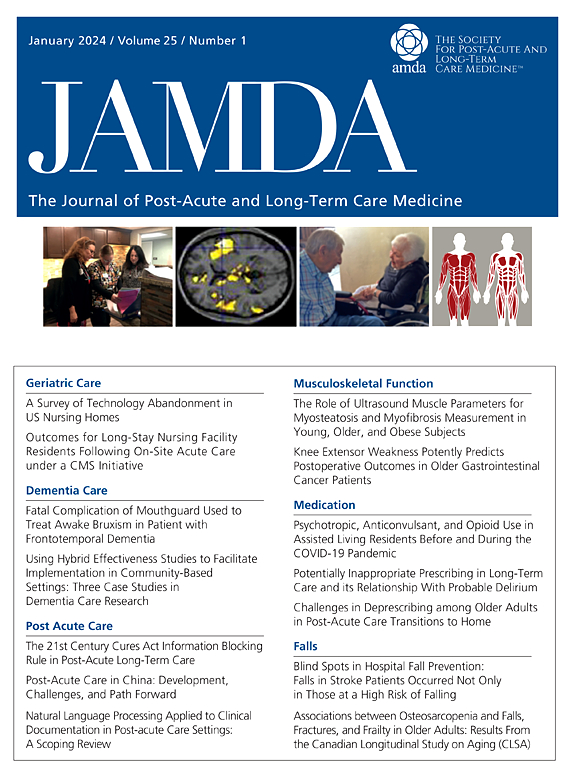全髋关节置换术术前骨骼肌质量对功能预后的影响。
IF 4.2
2区 医学
Q2 GERIATRICS & GERONTOLOGY
Journal of the American Medical Directors Association
Pub Date : 2025-02-01
DOI:10.1016/j.jamda.2024.105396
引用次数: 0
摘要
目的:探讨术前肌肉质量对全髋关节置换术(THA)术后功能结局的影响。设计:回顾性队列研究。背景和参与者:我们纳入了426名在2015年至2022年间接受了原发性THA的患者,以评估术前肌肉质量与THA后1年功能结局之间的关系。方法:采用术前计算机断层扫描法测量肌肉横截面积(CSA)和基线密度。CSA根据肌肉质量进一步分为肌内脂肪组织(IMAT)、正常密度肌肉(NDM)和基于肌肉密度阈值的低密度肌肉(LDM)。根据患者的功能恢复情况,将患者分为功能恢复充分(Harris髋关节评分[HHS]≥89)和功能恢复不足(HHS)两组。结果:使用倾向评分进行协变量调整后,对90对配对患者进行了分析。术前IMAT不足组各肌肉的IMAT均明显高于充足组(P < 0.05)。此外,足量组臀大肌、臀中肌和髂腰肌的肌肉密度和NDM显著低于足量组(P < 0.05)。相反,两组在LDM方面无显著差异。结论和意义:我们的研究结果显示,术前IMAT患病率明显较高且NDM减少的患者在THA后不太可能出现显著改善。因此,我们建议在肌肉质量良好的情况下进行THA是实现更高功能恢复的最佳时机。本文章由计算机程序翻译,如有差异,请以英文原文为准。
Impact of Preoperative Skeletal Muscle Quality on Functional Outcome in Total Hip Arthroplasty
Objectives
To investigate the effect of preoperative muscle quality on functional outcomes after total hip arthroplasty (THA).
Design
Retrospective cohort study.
Setting and Participants
We included 426 patients who underwent primary THA between 2015 and 2022 to evaluate the relationship between preoperative muscle quality and 1-year functional outcomes following THA.
Methods
The muscle cross-sectional area (CSA) and density at baseline were measured using preoperative computed tomography. The CSA was further divided based on muscle quality into intramuscular adipose tissue (IMAT), normal-density muscle (NDM), and low-density muscle (LDM) based on muscle density thresholds. According to their functional recovery, patients were classified into sufficient functional recovery [Harris hip score (HHS) ≥89] and insufficient functional recovery (HHS <89) groups based on their HHS at 1-year post THA. Propensity score matching was performed to balance the baseline characteristics of the patient groups, including age, sex, body mass index, HHS, University of California, Los Angeles activity scores, and gait speed. The preoperative muscle density, CSA, IMAT, NDM, and LDM of the gluteus maximus, gluteus medius, gluteus minimus, iliopsoas, and rectus femoris muscles were compared between the groups.
Results
Ninety matched pairs were analyzed following covariate adjustment using propensity scores. The insufficient group had significantly more IMAT in all muscles preoperatively than did the sufficient group (P < .05). In addition, the muscle density and NDM of the gluteus maximus, gluteus medius, and iliopsoas in the insufficient group were significantly worse than those in the sufficient group (P < .05). Conversely, the 2 groups showed no significant differences in LDM.
Conclusions and Implications
Our results revealed that patients with a significantly higher IMAT prevalence and reduced NDM preoperatively were less likely to experience significant improvement after THA. Therefore, we propose that undergoing THA with good muscle quality represents the optimal timing for achieving higher functional recovery.
求助全文
通过发布文献求助,成功后即可免费获取论文全文。
去求助
来源期刊
CiteScore
11.10
自引率
6.60%
发文量
472
审稿时长
44 days
期刊介绍:
JAMDA, the official journal of AMDA - The Society for Post-Acute and Long-Term Care Medicine, is a leading peer-reviewed publication that offers practical information and research geared towards healthcare professionals in the post-acute and long-term care fields. It is also a valuable resource for policy-makers, organizational leaders, educators, and advocates.
The journal provides essential information for various healthcare professionals such as medical directors, attending physicians, nurses, consultant pharmacists, geriatric psychiatrists, nurse practitioners, physician assistants, physical and occupational therapists, social workers, and others involved in providing, overseeing, and promoting quality

 求助内容:
求助内容: 应助结果提醒方式:
应助结果提醒方式:


